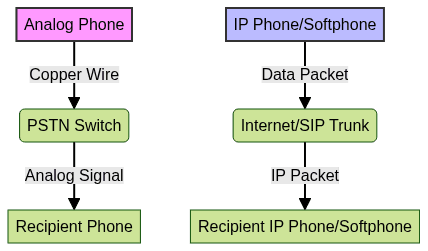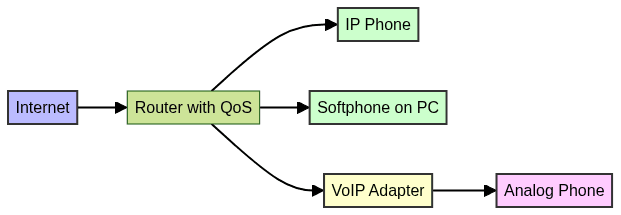Introduction to VoIP Lines
Voice over Internet Protocol (VoIP) lines have redefined communication in the digital era, enabling voice calls over the internet instead of traditional copper wires. In 2025, both businesses and residences are rapidly shifting to VoIP lines to leverage cost efficiency, advanced call features, and seamless scalability. With VoIP technology, organizations can streamline their communication infrastructure, integrate with modern software, and support remote workforces effortlessly. Understanding the components, setup, features, and security of VoIP lines is crucial for anyone managing IT or telecom systems today.
What Are VoIP Lines?
VoIP lines are digital pathways that transmit voice data over IP networks, using protocols like SIP (Session Initiation Protocol) for signaling and RTP (Real-time Transport Protocol) for media. Unlike the analog Plain Old Telephone Service (POTS), VoIP lines convert voice into data packets, route them over the internet, and reassemble them at the destination. This shift allows for far greater flexibility, lower costs, and integration with software systems. For developers seeking to integrate calling capabilities, leveraging a
phone call api
can streamline the process of embedding voice features into custom applications.Key Terminology:
- VoIP Line: A digital channel for internet-based voice calls
- SIP Trunk: A virtual version of an analog phone line, enabling multiple VoIP lines
- Cloud PBX: Hosted phone system managing VoIP lines and features in the cloud
- Softphone: Software-based phone running on computers or smartphones
- IP Phone: Hardware phone designed for VoIP networks
Traditional vs VoIP Call Flow

How Do VoIP Lines Work?
VoIP lines facilitate voice communication by converting analog audio signals into digital packets and transmitting them over IP networks. The workflow involves:
- Device Initiation: The user dials a number on an IP phone, softphone, or via a VoIP adapter connected to a traditional phone.
- SIP Registration: The device authenticates with the VoIP provider using SIP credentials.
- Call Setup: SIP messages establish a session between the caller and recipient.
- Media Transfer: Voice is encoded, packetized, and sent over the internet using RTP.
- Call Termination: The session ends with a SIP BYE message.
For developers building custom calling solutions, integrating a
Voice SDK
can provide robust audio features and seamless connectivity across platforms.Required Hardware & Software:
- VoIP Adapter: Bridges traditional phones to digital VoIP lines
- IP Phones: Purpose-built for VoIP networks
- Softphones: Software applications for desktops or mobile devices
If you’re developing for iOS, following a comprehensive
callkit tutorial
can help you implement native call handling and notifications within your VoIP app.SIP Registration Example (SIP Protocol Basics)
1REGISTER sip:voipprovider.com SIP/2.0
2Via: SIP/2.0/UDP 192.0.2.1:5060;branch=z9hG4bK123456
3Max-Forwards: 70
4From: "User" <sip:user@voipprovider.com>;tag=1122
5To: "User" <sip:user@voipprovider.com>
6Call-ID: 1234567890@192.0.2.1
7CSeq: 1 REGISTER
8Contact: <sip:user@192.0.2.1>
9Expires: 3600
10Content-Length: 0
11Types of VoIP Lines and Services
VoIP lines can be tailored for business or residential use, each with unique features and service models. The backbone of most VoIP deployments is SIP trunking, which allows multiple virtual phone lines over a single internet connection. Businesses often opt for cloud PBX or hosted PBX solutions, while clone lines and virtual numbers offer flexibility for both sectors.
For businesses aiming to add video communication, integrating a
Video Calling API
can enable seamless video meetings alongside voice calls.Business VoIP Lines
Business VoIP lines support advanced call routing, integration with CRM systems, unlimited calling, and multi-site connectivity. Features like call recording, voicemail to email, and E911 support are crucial for compliance and operational efficiency. Business VoIP solutions often include cloud PBX, allowing centralized management and scalability. Developers can enhance these solutions by embedding a
phone call api
to automate and manage calls programmatically.Residential VoIP Lines
Residential VoIP lines provide affordable internet calling with features like number porting, call forwarding, and voicemail. Users can choose between hardware-based IP phones, VoIP adapters for existing phones, or softphones for computers and smartphones. Residential users benefit from cost savings, simple setup, and access to advanced features previously reserved for enterprise systems. For those looking to add video capabilities to their home setup, you can
embed video calling sdk
for a plug-and-play experience.SIP Trunking and Cloud PBX
SIP trunking provides virtual phone lines over IP, replacing physical PSTN lines. Cloud PBX platforms manage these lines in the cloud, offering businesses robust call management, failover, and feature-rich interfaces without on-premises hardware. Utilizing a
Voice SDK
can further enhance your cloud PBX by enabling advanced audio features and real-time collaboration.Key Features of VoIP Lines
VoIP lines deliver an extensive range of features beyond traditional phone systems:
- Unlimited Calling: Many providers offer unlimited domestic and international calling plans, reducing costs.
- Call Forwarding & Call Waiting: Redirect calls to any device and manage multiple calls simultaneously.
- Voicemail to Email: Automatically send voicemails as audio files to your email inbox for easy access and archiving.
- Call Recording: Record calls for training, compliance, or quality assurance purposes.
- E911 Support: Enhanced 911 emergency calling with precise location information.
- Telemarketer Block: Block unwanted callers using advanced filtering algorithms.
- Bring Your Own Device (BYOD): Use existing hardware or softphones without vendor lock-in.
- Number Porting & Virtual Numbers: Retain your existing numbers or obtain numbers in different regions for a virtual presence.
- Clone Lines: Duplicate line functionality for shared or call center environments.
- Call Features: Include call transfer, music on hold, auto-attendant, and call queues.
For developers, integrating a
phone call api
allows you to automate these features and build custom call flows tailored to your business needs.These features empower businesses to optimize call flows, improve user experience, and ensure operational continuity.
Setting Up VoIP Lines
Implementing VoIP lines in a home or business environment involves several steps:
- Assess Network Readiness: Ensure the internet connection has sufficient bandwidth (at least 100 kbps up/down per line) and low latency.
- Choose a VoIP Provider: Evaluate providers for reliability, features, pricing, and support.
- Select Devices: Decide between IP phones, softphones, or adapters for analog phones.
- Provision Hardware and Software: Configure devices with SIP credentials from your provider.
- Network Configuration: Prioritize VoIP traffic using QoS (Quality of Service) on your router.
- Testing & Troubleshooting: Make test calls, check audio quality, and resolve issues like jitter or dropped calls.
If you’re building a VoIP app for iOS, following a
callkit tutorial
ensures your app integrates seamlessly with the native call interface and provides a better user experience.Home/Office VoIP Network Setup

Common Setup Issues & Troubleshooting Tips:
- One-way audio: Check NAT/firewall configuration.
- Call drops: Inspect internet stability and QoS settings.
- Registration failures: Verify SIP credentials and provider settings.
- Poor quality: Reduce network congestion and upgrade bandwidth if needed.
Cost Benefits of VoIP Lines
VoIP lines drastically reduce communication expenses by eliminating costly PSTN circuits, per-line fees, and expensive hardware. Businesses can scale up or down without penalties, and many providers offer bundled unlimited calling plans, further enhancing cost savings.
For organizations exploring VoIP, many platforms allow you to
Try it for free
before making a long-term commitment, making it easier to evaluate features and performance.Example Cost Comparison Table
| Feature | Traditional Landline | VoIP Lines (2025) |
|---|---|---|
| Lines/Users Included | 1 per line | Unlimited/Plan-based |
| Monthly Fee (per line) | $25 | $5 - $15 |
| International Calls | High cost | Often included |
| Advanced Features | Limited | Extensive |
| Hardware Costs | High | Low/Bring your own |
| Setup Time | Days/Weeks | Minutes/Hours |
This table illustrates potential monthly savings and feature enhancements with VoIP lines.
Security and Reliability of VoIP Lines
Security is paramount for VoIP lines. Protecting against eavesdropping, toll fraud, and DDoS attacks requires:
- SIP TLS & SRTP: Encrypt signaling and media streams.
- Strong Authentication: Use complex SIP passwords and two-factor authentication.
- Firewall & NAT Traversal: Harden your network against unauthorized access.
- Regular Updates: Patch VoIP software and firmware often.
E911 & Emergency Calling: Modern VoIP providers offer E911, routing calls to local emergency services with location data. Always verify E911 support and update your address records.
Network Uptime & Redundancy: Look for providers with high SLAs, redundant data centers, and failover routing to ensure business continuity.
Choosing the Right VoIP Line Provider
When selecting a VoIP provider, consider these key factors:
- Reliability & Uptime: Choose providers with 99.99%+ uptime guarantees.
- Feature Set: Confirm support for SIP trunking, cloud PBX, call recording, BYOD, and advanced call routing.
- Support: 24/7 technical support and active developer communities are critical.
- Pricing: Transparent, scalable pricing with no hidden fees.
For developers and businesses seeking to build advanced communication solutions, integrating a
phone call api
offers flexibility and scalability for both voice and video communication needs.Popular VoIP Providers (2025)
| Provider | Best For | Key Features |
|---|---|---|
| Twilio | Developers/SMBs | API integration, global reach, BYOD |
| RingCentral | Enterprises | Cloud PBX, advanced analytics, E911 |
| 8x8 | Global Businesses | Unlimited calling, call recording |
| Vonage | Small Businesses | Number porting, mobile apps, virtual lines |
Conclusion
VoIP lines deliver scalable, feature-rich, and cost-effective communication for businesses and homes in 2025. By understanding VoIP technology, setup, security, and provider selection, IT pros and developers can future-proof their communications. Now is the perfect time to consider switching to VoIP lines for superior flexibility and savings.
Want to level-up your learning? Subscribe now
Subscribe to our newsletter for more tech based insights
FAQ